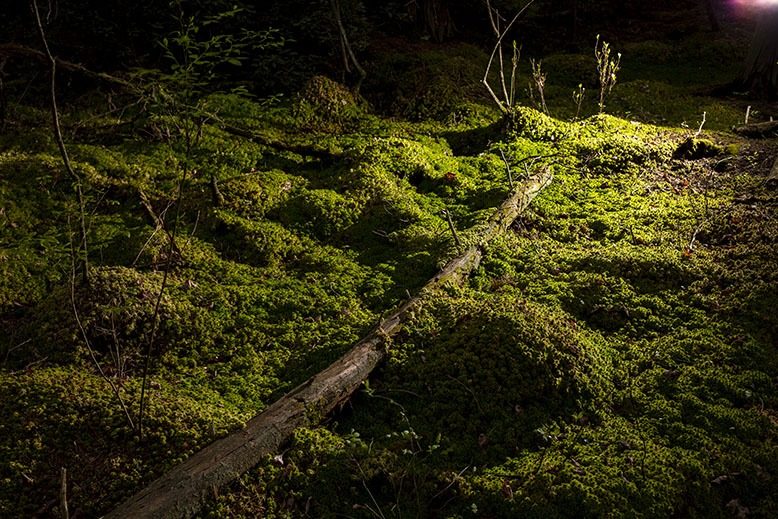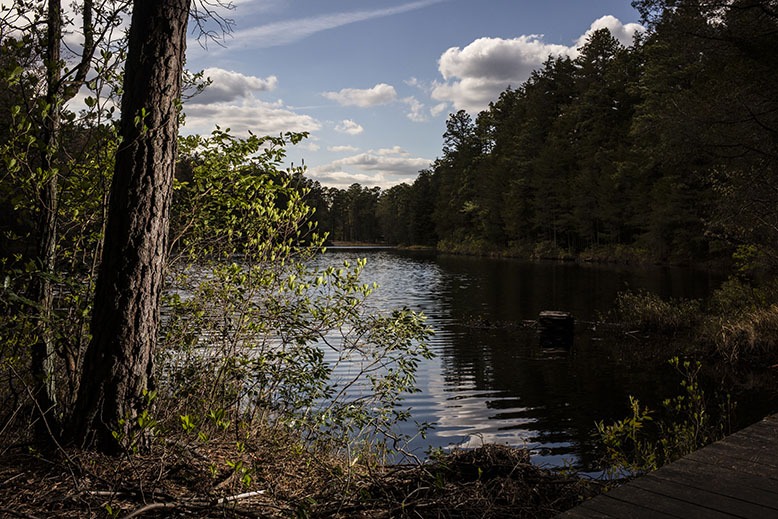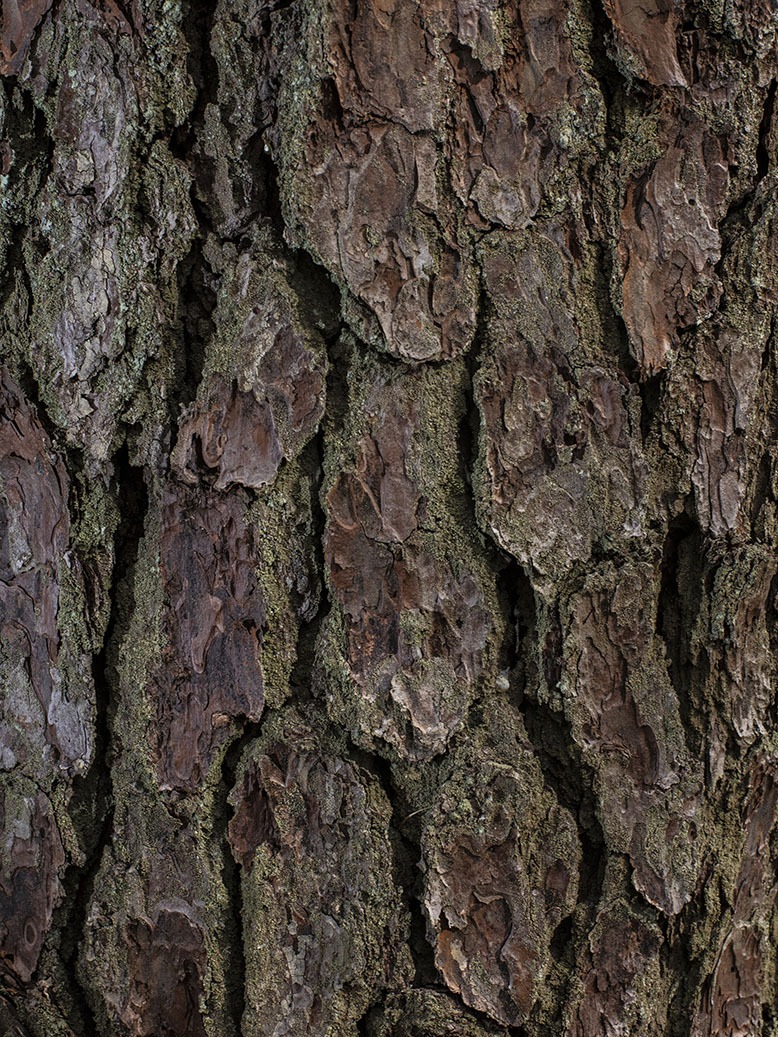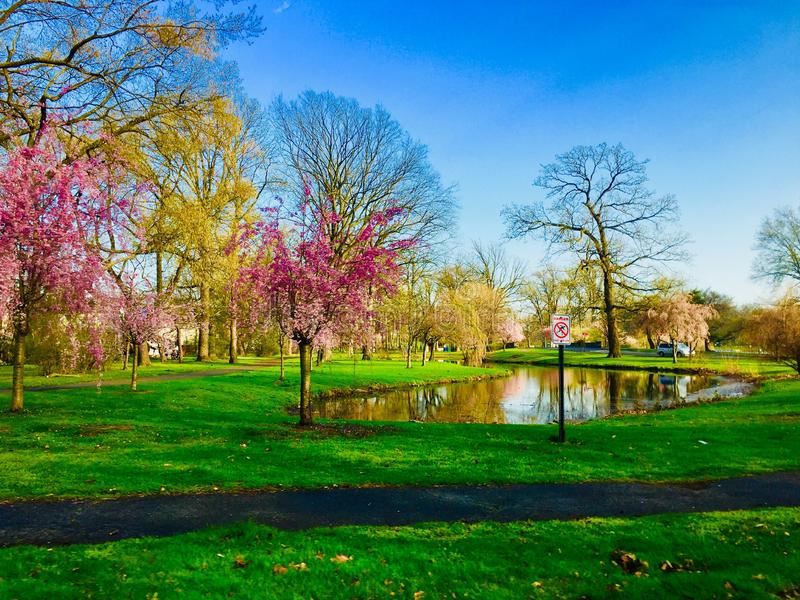Large, resilient, connected forest landscapes are vital for the conservation of biodiversity—and to combat global warming.
By Pamela Weber-Leaf | | July 10, 2023 | Appears in the July 2023 issue

Brendan T. Byrne State Forest, located in the Pine Barrens, spans over 38,000 acres of land. Photo: Bryan Anselm
They cover nearly 2 million acres across the state—verdant expanses, rich in varied wildlife, that have caught the attention of equally varied human advocacy groups. New Jersey’s forests account for two-fifths of its land—proportionally greater than half the states in the country. And, with the increasing recognition of trees’ importance in combating climate change, proper management of these wooded parcels has never been more critical.
In 2023, few would contest the value of large, resilient and connected forest landscapes for the conservation of biodiversity, plant and animal migration corridors, and to combat global warming; healthy trees reduce atmospheric carbon by storing the element in new growth. Preserving forest health also means protecting soil and water quality, controlling invasive plant species, and limiting risk of wildfire. Among environmentalists, commercial loggers, government agencies and outdoor-recreation enthusiasts, the best way to achieve all this has long been hotly debated, but has never been officially determined—at least not in the eyes of the law.
The matter is now getting a formal hearing. New Jersey’s first ever Forest Stewardship Task Force submitted its report this year to the state Legislature’s Joint Committee on the Environment, with the full Senate and Assembly expected to vote later this year on binding regulations that follow from the report. The rules would apply to all forests under state or local control. This encompasses nearly 900,000 acres, from the oak, maple and hickory-dotted Highlands in northwestern New Jersey down to the Pine Barrens, whose namesake trees include large stands of pitch and a half-dozen other pine species. According to just about everyone who cares about these arboreal gems, a clear mandate is long overdue.
[RELATED: Meet the Man Who Oversees All of NJ’s Trees]

Pakim Pond along a portion of the Batona Trail in Brendan T. Byrne State Forest. Photo: Bryan Anselm
“Every forest in New Jersey is up for grabs,” says Anjuli Ramos-Busot, director of the state’s Sierra Club and one of four task force members. “We needed a framework that addressed things holistically and reached a consensus for all the stakeholders. This promotes a science-based approach to achieve climate and ecological objectives.”
The main controversy is whether and where to continue allowing logging, and it has inflamed passions to wood-scorching levels. As designed by state Senator Bob Smith, a Central Jersey Democrat who chairs the Senate’s Environment and Energy Committee, the rules were crafted to incorporate the ideas of two-thirds of the organizations and individuals involved in the process. The resulting compromise permits some logging, which, advocates argue, generates less emission of carbon dioxide and other ozone-depleting greenhouse gasses than the transportation required to import the hardwoods New Jersey’s construction industry needs. But, the dissenting third disputes this, claiming that much of the state’s harvested wood is exported anyway.
“When we talk about deforestation in the Amazon or Indonesia, everyone goes, ‘That’s so horrible,’” says Ken Dolsky, vice president of New Jersey Forest Watch, a statewide nonprofit that submitted an extensive rebuttal to the report. “But here in New Jersey, the [practice] is twisted into something they’re doing for the health of the forest. That is just outrageous.”

The trunk of an Atlantic white cedar. Photo: Bryan Anselm
Outrage over clear-cutting on a relatively small tract at wildlife-rich Sparta Mountain led to the creation several years ago of Forest Watch. The group is part of an organized Highlands Coalition intent on preserving a continuous tree canopy that many environmentalists say is essential to curtail stormwater runoff and maintain a clean drinking-water table. But beyond the patchwork of old- and newer-growth forest lies a tangle of other issues the task force addressed, namely, preventing the region’s ubiquitous deer from destroying new forest growth and curtailing invasive plant species that jeopardize biodiversity. Also beyond the reach of the proposed regulations lie the other half of the state’s forests—the 48 percent on privately owned land and another 7 percent under federal control, in places like the Delaware Water Gap and New Jersey’s 72-mile segment of the Appalachian Trail.
[RELATED: Meet the Handful of Locals Rescuing Our State’s Threatened Trees]
Neither of these forest categories has been the source of frequent protest. Development proposals on federally owned land are few and far between. The 950,000 forested acres outside any government jurisdiction run the gamut from hundreds of small family- and company-owned parcels to larger tracts still under a square mile, plus a small percentage that nonprofit land conservancies have purchased over the years to preserve in perpetuity. These groups also buy public lands; when the New Jersey School of Conservation (NJSoC) in Stokes State Forest, the nation’s oldest resident environment field center, was slated for closure due to budget cuts at owner Montclair State University, a hastily assembled Friends of the NJSoC stepped in to acquire and manage the property. Occasionally, the government buys directly from a landowner for preservation purposes; the Catholic Church sold approximately 32 acres of pristine forest, called Bretton Woods, to Ocean County after local outcry over a planned housing development. But, as other privately held land is slowly tapped for timber, the task force’s forest-industry representative points out that lessons learned from his consulting experience apply to all proposed logging on public lands.
“I literally work in the woods,” says Andy Bennett of the New Jersey Forestry Association. “Some forests are crowded or completely overfull. They face immense pressure and need shepherding to help along the natural aging processes. The science absolutely doesn’t support leaving everything alone.”

New leaves sprout along a creek which has been darkened by pine tannins. Photo: Bryan Anselm
One generally accepted form of shepherding is limiting the spread of non-native flora and fauna, including insects and microorganisms, that suffocate their native cousins. A task force recommendation to reconvene the Invasive Species Council, created in 2004 but dismantled by former governor Chris Christie, was widely applauded; New Jersey is one of three states with no comprehensive strategy on invasives. Proposed legislation would require a permit to grow and sell species such as honeysuckle; Japanese barberry, a popular ornamental plant; and garlic mustard, an herb used for cooking.
Almost everyone following the latest developments also champions prescribed burns, setting carefully controlled fires to reduce overgrown brush and some trees that provide fuel for wildfires. Yet preemptive strikes were no match for this past spring’s drought-like conditions, which sparked a conflagration in Manchester’s Pine Barrens and two other large blazes across the state in one terrible week in April. Almost 6,500 acres were decimated. And, in June 2022, a single blaze more than twice that size, likely caused by an illegal campfire, scorched the Pine Barrens’ Wharton State Forest, New Jersey’s largest forest.
Equally destructive, if less dramatically so, is New Jersey’s white-tailed deer population, currently around 125,000. A century ago, it was essentially zero. Today, while some might say the deer’s beauty compensates for traffic disruption, trampled gardens and other suburban inconveniences, they are far more dangerous to Jersey’s forests. Considered an ecosystem engineer, the deer is the forest’s main wildlife villain on many levels, degrading deciduous, or non-evergreen, trees on a huge scale. But, the best way to thin the herd has divided forest stewards, perhaps more than any other question.

Bark on a pine tree. Photo: Bryan Anselm
At the New Jersey Conservation Foundation (NJCF), one person has made it his life’s mission to thwart deer from devouring the understory—the layer of shrubs, vines and saplings between the forest floor and the mature tree canopy. This forest lifeblood can thrive only if hunting rules are designed to facilitate ecological sustainability rather than recreation, says Emile DeVito, the organization’s manager of science and stewardship, who holds a doctorate in ecology. With wolves long gone from New Jersey’s wilds, the deer have no natural predators.
An experiment the NJCF launched in the mid-1990s to demonstrate the importance of deer scarcity was wildly successful. Installing small fenced-in areas at Watchung Reservation prevented the animals from browsing, and the bucks from the habitual antler rubbing that strips protective outer bark from trees. The fences have space underneath to let in rabbits and rodents, proving that smaller mammals are not the real problem. Sheltered from their own biggest predator, the trees inside these enclosures have matured to shade the understory, allowing growth of maple leaf viburnum and other native species well adapted to low light.
Nature, it seems, loves a deer vacuum.
“Thirty years ago, this looked like a bowling alley,” says DeVito, sweeping his arms dramatically beside the original chain-link Deer Impact & Plant Regeneration Study Area, lush even in late March, before leaves appear on the deciduous trees. “Today, you’ve got no invasives here at all. The forest has completely regenerated.”
Short of fencing the entire state, DeVito says, officials need an aggressive strategy that de-emphasizes trophy hunting of the antlered males and legalizes commercial venison, as Pennsylvania has done. New Jersey Fish & Wildlife, a division of the state Department of Environmental Protection (DEP), has no plans to do so.
But Larry Herrighty, a former Fish & Wildlife official who represents the New Jersey Outdoor Alliance (NJOA), a consortium of hunters, notes that the practice has helped reduce the population by 40 percent from its mid-1990s high. “This state has one of— if not the most—liberal deer-hunting regulations in the U.S.” says Herrighty, who cited other control measures such as widespread contraception, as impractical. “To call deer overabundant everywhere is a huge overgeneralization.”

Pine needles on the forest floor. Photo: Bryan Anselm
Deer aside, it is the fight over logging that has the most people upset. Certain forested areas of the state already benefit from some level of protection. Development in the Pine Barrens was limited by a 1979 state law, although the new rules would significantly increase scrutiny of any proposals. In the vast New Jersey Highlands region, whose eastern boundary stretches 60 miles across seven counties, commercial intrusions are largely forbidden in certain areas, such as West Milford, by existing legislation. The task force report also includes a provision to prioritize reforestation of previously cleared areas that will best sequester carbon dioxide. Small consolation to the stalwart defenders of Sparta Mountain, which sits outside the strongest protection zone, and to those outraged over removal of 21 acres of mature upland forest in Glassboro earlier this year with scant public notice. The DEP had authorized that project to create a meadow habitat for a shorebird, the American woodcock sandpiper, which it considers a “species of concern”—a classification two steps short of endangerment.
[RELATED: A Quick Guide to Planting Trees in New Jersey]
For most New Jersey residents, including the cohort watching the regulatory process unfold in Trenton, naysayers focused on these isolated preservation lapses aren’t seeing the forest for the trees. Regardless, forest stewards whose job it is to promote public enjoyment of nature’s majesty encourage people to get out and appreciate it for themselves. The New York-New Jersey Trail Conference, which maintains 682 forested miles throughout the state, saw a large uptick of visitors during the pandemic, according to spokesman Don Weise—and that’s a good thing. Pausing during a hike below Ramapo Reservation’s picturesque MacMillan Falls, Weise says, “These forests are an invaluable resource. We hope everyone can come experience this nature and instill in their kids the need to value and protect it.”
And, perhaps, own it, in the best possible way. Chief Vincent Mann of the Ramapough Lenape Nation, denizens for centuries of the land where Weise lightly treads, states it simply: “We ask that the trees in public forests be accorded the respect of a living person, as our cousins or grandparents. They may willingly give of themselves, as we would give of ourselves, as our mothers would give to sustain her children.”
Pamela Weber-Leaf’s editorial career included the environment beat at two daily newspapers. She is a nonpracticing environmental lawyer.



